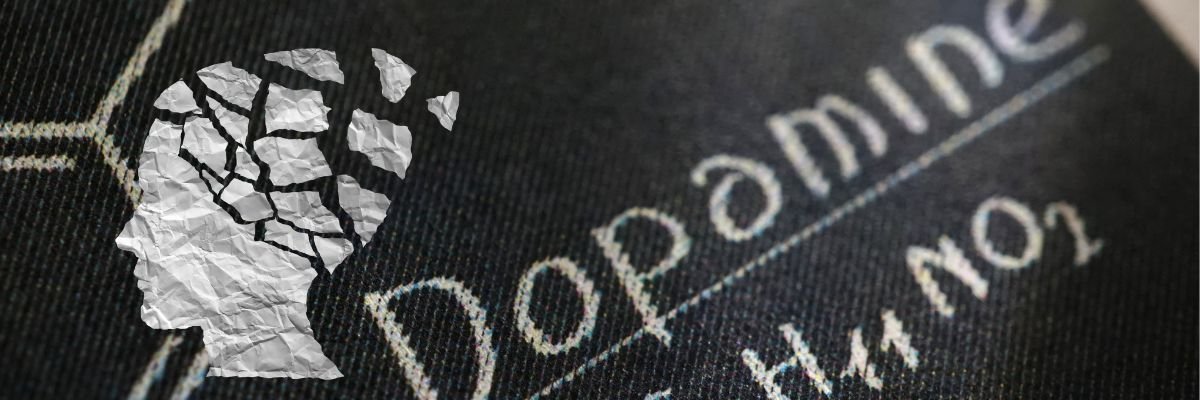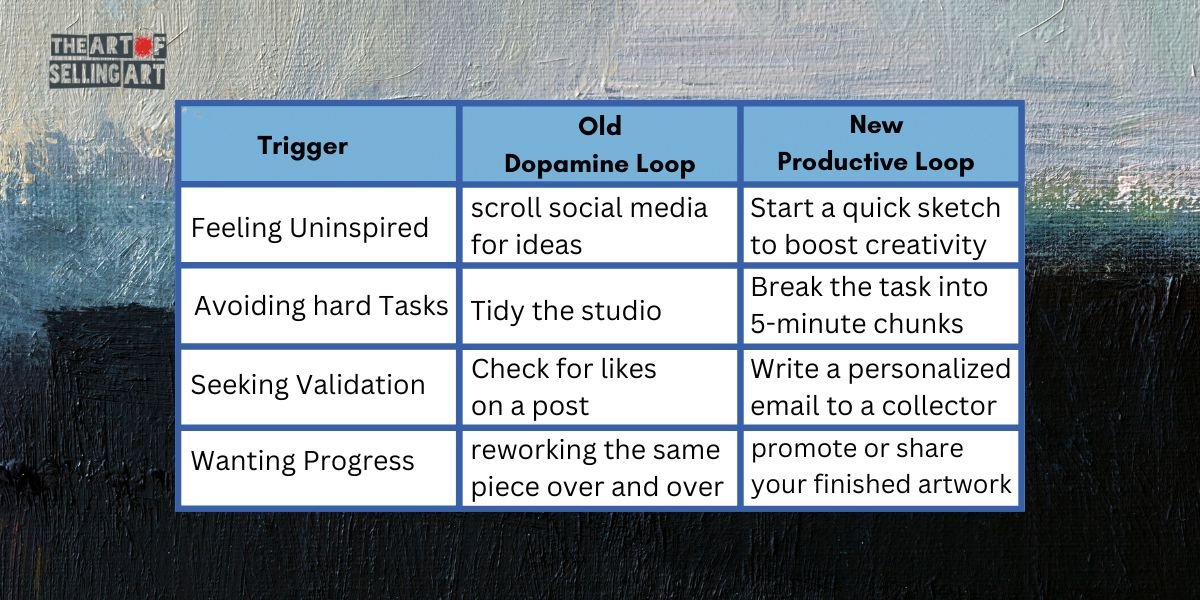The Hidden Trap of Hard Work: Dopamine Loops
Many artists work tirelessly but still feel stuck—putting in effort without seeing the results they crave. One big reason? They might be caught in unproductive dopamine loops, where their brain’s reward system prioritizes immediate gratification over meaningful progress.
Dopamine makes us feel good when we take action, but not all actions are created equal. If your hard work is spent chasing small, short-term wins (like refreshing social media or organizing your workspace) instead of focusing on high-impact tasks, you’ll stay busy without moving forward.
How Dopamine Loops Hold Artists Back
Here’s how it shows up in an artist’s life:
Social Media Traps: Posting artwork and checking for likes or comments feels rewarding, but it doesn’t directly lead to sales or meaningful collector relationships.
Avoidance Patterns: Tasks like brainstorming titles or rearranging your studio might feel productive, but they’re a way to avoid harder, goal-oriented tasks like writing a sales email or pitching your work.
Busy Work Over Strategy: Checking off easy to-do list items creates quick dopamine hits but doesn’t push your business forward in measurable ways.
Turning Dopamine Loops into Productive Cycles
To break the cycle, you need to intentionally redirect your brain’s craving for dopamine toward actions that align with your larger goals. This means shifting from “What feels good right now?” to “What will bring meaningful results?”
Gamify High-Impact Tasks
Break down daunting tasks into smaller, dopamine-rewarding steps.
Example: Instead of “Sell my artwork,” focus on:
Reaching out to one past collector.
Writing one post with a call-to-action.
Uploading one piece to your website.
Celebrate each step as a win, retraining your brain to associate hard work with reward.
Create Rituals That Delay Gratification
Dopamine thrives on anticipation. Use this to your advantage:
Before you start your day, visualize the outcome of completing your key task (a new collector, a growing audience, etc.).
Save rewards (like checking social media) for after you’ve completed a meaningful goal.
Prioritize Long-Term Wins Over Quick Hits
Train yourself to favor actions that move the needle:
Replace: “What should I post today?”
With: “How can I build a deeper relationship with one collector today?”
Example: Instead of constantly tweaking your website for instant gratification, focus on sending an email that invites past collectors to view a new collection.
Track Progress Visually
Use tools like habit trackers or sales trackers to turn long-term efforts into visible wins.
Watching your progress builds momentum and reinforces productive behaviors.
The Artist’s Dopamine Toolkit
Here’s a quick framework to help artists stay intentional:
The secret to making real progress isn’t just working hard—it’s working smart. By understanding how dopamine loops affect your actions, you can redirect your energy toward the tasks that matter most: building relationships, sharing your story, and creating a sustainable art business.
When you align your hard work with intentional goals, the rewards will follow—not just in dopamine hits, but in real, tangible progress.
Dopamine Detox and Recalibration for Artists
Reset Your Mind and Reclaim Your Focus
Purpose: A dopamine detox is a short-term reset to reduce overstimulation from instant gratification activities. It helps recalibrate your brain’s reward system, making it easier to focus on meaningful, long-term goals.
Why It Matters for Artists: Constant distractions (social media, notifications, etc.) can pull you away from creating and building your art business. A detox gives you space to regain clarity and intention.
Part 2: How to Do a Dopamine Detox
Step 1: Identify Overstimulating Activities
Reflect on habits that provide instant gratification but don’t serve your goals (e.g., endlessly scrolling, binge-watching, or checking for likes).
Example for Artists: Refreshing Instagram for likes instead of creating or engaging with collectors.
Step 2: Set a Detox Period
Choose a specific time frame for your detox (e.g., 24 hours, a weekend). During this time, avoid overstimulating activities like:
Social media.
Streaming platforms.
Junk food or mindless snacking.
Checking sales/emails obsessively.
Step 3: Replace with Low-Stimulation Activities
Fill the detox period with intentional, low-stimulation actions that support creativity and mindfulness:
Sketching or painting without a goal.
Journaling about your art or business intentions.
Taking a walk or meditating.
Reading an inspiring book.
Part 3: Recalibrating with Productive Dopamine Loops
After the detox, reintroduce activities in a way that aligns with your long-term goals. Use the worksheet to replace unproductive loops with meaningful habits.
The Recalibration Framework:
Part 4: Action Plan for Artists
Step 1: Plan Your Detox
Detox Period: _____________________ (e.g., 24 hours or 48 hours).
Activities to Avoid: _________________ (list overstimulating habits).
Low-Stimulation Alternatives: ____ (list calming, intentional activities).
Step 2: Use the Dopamine Loop Worksheet
Post-detox, use the worksheet to map out unproductive loops and replace them with productive ones.
Step 3: Set Weekly Goals
Identify 2-3 high-impact tasks each week that align with your art and business goals. Track your progress using the worksheet.
Part 5: Reflect and Adjust
At the end of the week, ask yourself:
How did the detox and recalibration impact your focus and creativity?
Which productive habits felt most rewarding?
What adjustments can you make to strengthen your routine?
Learn How To Become A Successful Artist
With 60+ Hours of Education, Case Studies, and Live Training derived from tested strategies and applications, this program is meant to raise the tide for all artists!
Whether you are a novice, intermediate, or experienced in selling your art, there are key takeaways for every level of understanding.
You won’t be doing it alone, either. You’ll be supported through private AMAs and our community as well.






